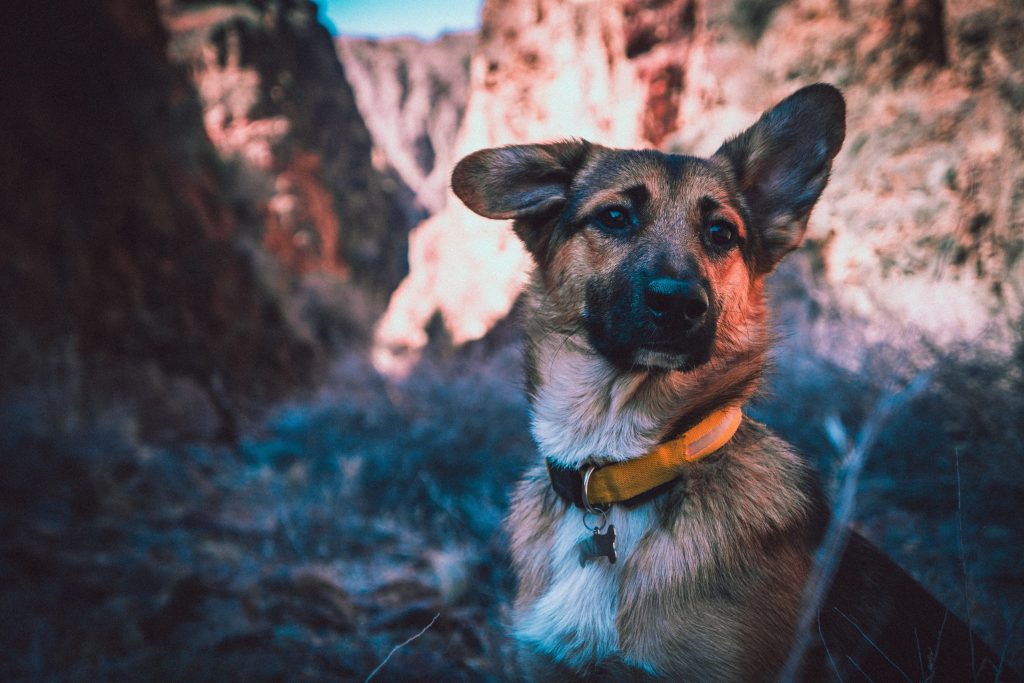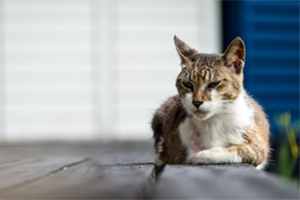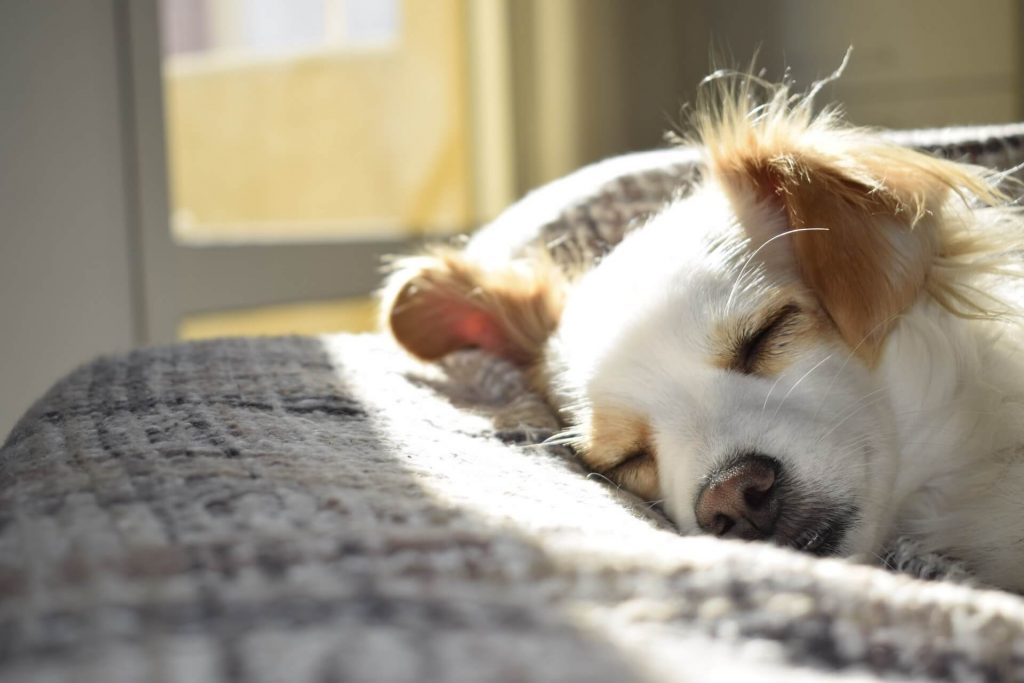Time to read: 8 mins
Key Stats
Life expectancy: 12 – 14 years
Height: 33 – 41 cm
Weight: 11 – 17 kg
All About Staffordshire Bull Terriers
Staffordshire Bull Terriers, affectionally known as Staffies, are a loving and caring breed that make for the perfect family pet. They are lively, sweet-natured, affectionate and very loyal.
Staffies might be a little short in stature, but they are incredibly strong! both in their muscular bodies and stance. They can look somewhat intimidating, but that couldn’t be further from the truth. These dogs love to play and are actually very sensitive.
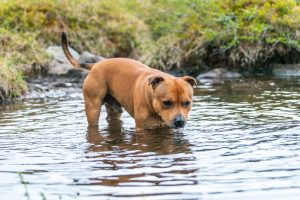
What to consider when owning a Staffordshire Bull Terrier
Although they are great family pets, Staffies are well-suited to experienced pet owners that can train and socialise their dog from an early age.
They can be very needy and will not appreciate being left alone for extended periods of time. This is largely because they are companion dogs that crave human interaction.
Staffies have a strong desire to chase after small animals, this should be monitored when they are out and about. Cats are part of this group too, bare this in mind if you already have a cat at home or are thinking of getting one. However, your Staffie can be taught not to chase your cat, if trained correctly.

Cost
Many Staffies can be found homed at rescue shelters, so where possible, it would be best to adopt rather than shop. If shopping is the intention, then Staffie puppies can cost anywhere from £1,000 to £2,000 depending on their lineage.
On top of the purchase price you’ll also need to consider initial costs for things such as vaccinations and neutering, as well as ongoing costs of food and preventative healthcare. Some of these extra charges include:
- Microchipping
- Flea treatments
- Leash and collar
- Treats and food bowls
- Toys
- Beds
- Grooming
- Insurance
Grooming
Staffordshire Bull Terriers are relatively easy to groom. They have a short-haired coat that has minimal shedding potential. Brush them weekly to get rid of any dirt or excess hair.
Exercise
Staffies are very energetic and will require about 2 hours of exercise a day, depending on your dog and their age. Exercise can come in the form of walks or playtime. You can include mental stimulation to keep your Staffie busy too!
Staffordshire Bull Terrier health considerations
Like all pedigree dogs there are a few breed specific conditions you should be aware of.
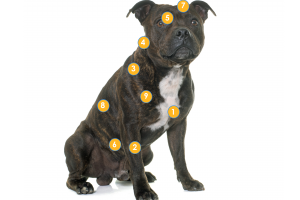
1. Heart
Heart disease is a leading cause of death in older Staffies. Signs of heart disease that should not be ignored include dogs becoming short of breath and unable to exercise or play as much as they used to; coughing or breathing difficulties, a swollen belly, loss of appetite, weight loss or muscle wastage.
PDA (Patent ductus arteriosus) or ‘hole in the heart’ is a condition that is faced by many dog breeds. This is a rare genetic defects that may not be apparent at birth. It is often diagnosed when a vet hears a heart murmur during routine check-ups. Surgery is required to prevent heart failure.
Another birth defect is PSS (Porto-systemic shunt). This is when part of the circulatory system doesn’t develop normally. It affects the liver, digestion and normal growth. Puppies can fail to thrive, although sometimes this condition is only picked up at 1-2 years old. An affected puppy or dog may not want to eat, could vomit, have fits or collapse. Surgery can correct the problem successfully.
2. Bone problems
Many different breeds can suffer from hip or elbow dysplasia. In the hips, the joints don’t fit together perfectly. Signs include walking stiffly, hip pain and difficulty getting up from a sitting position. In the elbows, one or both elbows develop abnormally and may look bowed.
Both conditions cause pain, swelling and eventually arthritis. Maintaining a heathy weight alongside a good quality diet and food supplements for joint health can help. Dysplasia can be screened for by reputable breeders who will have the parents’ joint alignment assessed and scored by vets before deciding to breed from them.
If the ligament holding the kneecap in place isn’t in normal alignment it can cause the kneecap to snap in and out of place (luxating patella). Dogs may sometimes ‘leave out’ one of their legs when walking or running or not use that leg at all. Some dogs find this painful, plus it can put a strain on other parts of the knee and cause arthritis. Surgery can help to correct the problem. Maintaining a healthy body weight and using food supplements for joint health can help.
3. Cancers
In common with all dog breeds, cancer can sadly affect some Staffies. Some cancers are more common than others in this breed. Some cancers that Staffies are prone to are; mast cell tumours (they initially look like skin lumps) and tumours of the spleen and liver. Signs to look out for include weight loss, unusual tiredness or lethargy or a swelling in their abdomen. If you notice any of these you should contact your vet sooner rather than later.
4. Cushings disease
Cushings (hyperadrenocorticism) is caused by the body producing too many natural steroid hormones. It can be difficult to detect as it develops slowly but signs to look out for include drinking and /or urinating more than normal, increased appetite, potbelly, thinning skin that bruises easily and hair loss. Once diagnosed, the dog will need lifelong medication and regular check-ups with blood testing to maintain a good quality of life.
5. Eyes
Juvenile cataracts are a result of a genetic characteristic known as CHC. This causes some Staffies to develop cataracts at an early age. This condition can be screened for by breeders. Any milkiness of the lens in a dog of any age should be checked by a vet. If the vision is affected, it may be possible to restore it by specialist surgery.
6. Lumps and bumps
Older Staffies often have various permanent lumps and bumps under and on the surface of the skin. The majority of these are benign but new lumps, lumps that change size or shape or have any discharge or that bleed, should be checked out by a vet.
7. Metabolic / Neurological
L2-HGA is an inherited metabolic condition affecting the brain and spinal cord. Puppies between 6-12 months may have a wobbly or clumsy gait, tremors and muscle stiffness (often made worse by exercise) and seizures. It can also show up later in life. The condition is only recently recognised in dogs, with Staffies and West Highland Terriers known be affected, and the prognosis is guarded. However, there have been recent promising developments in treatment for this condition. Breeders can screen for this condition to help reduce the chance of passing it on to future generations.
8. Separation anxiety
These loyal dogs love to be around their people, and they can become anxious when left alone. They can show this by whining, barking, over-grooming or destructive behaviour like chewing. No dogs should be left alone for more than four hours, but Staffies may struggle with shorter periods than this. It will help to train your Staffie to see their crate as a safe place, provide boredom-busting toys and gradually build up the time they spend alone.
9. Skin/Allergies
With their particular type of hair and sensitive skin, Staffies can be prone to itchy skin conditions caused by mites, food or environmental allergies. Your vet can advise on the right anti-parasite treatments and shampoos to use. They can also help find out the cause if you think your Staffie has allergies. White or pale Staffies may need unperfumed sunscreen on their ears and nose in the summer months to prevent sunburn and protect against skin cancer.
If you have any concerns about your dog’s health do not hesitate to get in touch with our Careline. They will be able to answer any questions that you may have.
Pet insurance for Staffordshire Bull Terrier
Staffordshire Bull Terriers, like most pure-bred dogs, have their accompanying health issues. You never know what might happen as they get older. Find out how we can cover your pet from accidents as well as illnesses they may suffer from.
It’s normally best to insure your dogs from a young age, before any conditions become an issue. Insuring your Staffie from a young age will tend to be cheaper. Although you can get insurance for older dogs too.
Join us today
Getting a quote for your dog or cat takes just 3 minutes.


